
Leucopogon is a genus of about 150-160 species of shrubs or small trees in the family Ericaceae, in the section of that family formerly treated as the separate family Epacridaceae. They are native to Australia, New Zealand, New Caledonia, the western Pacific Islands and Malaysia, with the greatest species diversity in the south-west of Western Australia. Plants in this genus have leaves with a few more or less parallel veins, and tube-shaped flowers usually with a white beard inside.

The Gnaphalieae, commonly known as paper daisies, are a tribe of flowering plants in the family Asteraceae. It is most closely related to the tribes Anthemideae, Astereae, and Calenduleae.
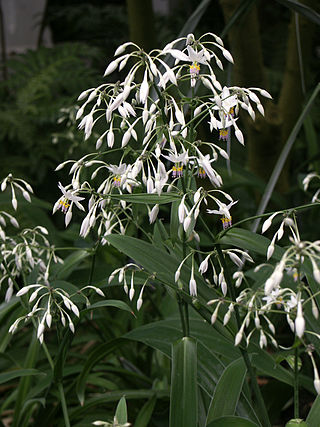
Arthropodium is a genus of herbaceous perennial plants in the subfamily Lomandroideae of the family Asparagaceae. Members of this genus are native to Australia, New Zealand, New Caledonia, and Madagascar.

Centrolepis is a genus of small herbaceous plants in the family Restionaceae known as thorn grass scales, with about 25 species native to Australia, New Zealand, New Guinea, and south-east Asia as far north as Hainan Dao. APG III system classifies this genus in the Centrolepidaceae family.

Levenhookia dubia, the hairy stylewort, is a dicotyledonous plant that belongs to the genus Levenhookia. It is an ephemeral annual that grows from 2–6 centimetres (0.79–2.36 in) tall with obovate leaves that are generally 2–5 millimetres (0.079–0.197 in) long. Flowers are white and bloom from September to October in its native range. L. dubia is most closely related to L. sonderi, which has been described as a variety of L. dubia in the past. It is endemic to Australia and has native ranges in Western Australia, South Australia, New South Wales, and Victoria. Its habitat has been reported as being sandy soils in granite outcrops.

Erechtites is a genus of flowering plants in the daisy family known commonly as fireweeds or burnweeds. They are native to the Americas and Australia, but some species are widely distributed weeds.

Calomeria is a plant genus in the family Asteraceae.
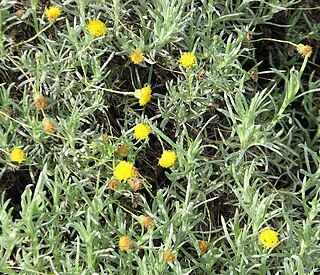
Leiocarpa is a genus of plants in the family Asteraceae, native to Australia.
Leptorhynchos is a genus of annual or perennial herbs in the family Asteraceae. All species are endemic to Australia.
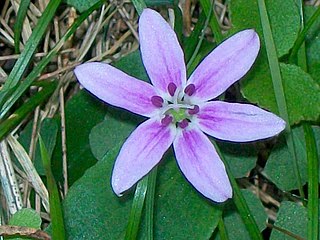
Schelhammera is a genus of perennial flowering plants in the family Colchicaceae, comprising two species.
Millotia is a genus of small annual herbs in the tribe Gnaphalieae within the family Asteraceae.

Trichanthodium is a genus of Australian plants in the tribe Gnaphalieae within the family Asteraceae.
Eriochlamys is a genus of Australian flowering plants in the family Asteraceae.

Euchiton is a genus of flowering plants in the family Asteraceae. They are native to Australasia and the Pacific. Some have been introduced far outside their native ranges.

Ixiochlamys is a genus of Australian flowering plants in the family Asteraceae.

Pogonolepis is a genus of Australian plants in the tribe Gnaphalieae within the family Asteraceae.
The Burrinjuck Nature Reserve is a protected nature reserve on the south west slopes of New South Wales, Australia. The 5,250-hectare (13,000-acre) reserve is located adjacent to the Burrinjuck Dam, with 5,118 hectares of the reserve located on the northern side of the reservoir, and the remaining 89 hectares located on the southern side of the reservoir to the northeast of Black Andrew Nature Reserve. It includes land formerly managed as the Burrinjuck State Forest and Burrinjuck State Recreation Area.
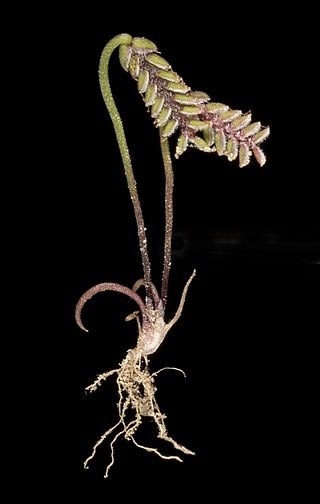
Aphelia is a genus of plants in the Restionaceae family. The entire genus is endemic to Australia. APG III system classifies this genus in the Centrolepidaceae family.

Actinobole uliginosum, the flannel cudweed, is a species of dwarf annual herb in the family Asteraceae, which is endemic to Australia. It occurs in every state of mainland Australia.
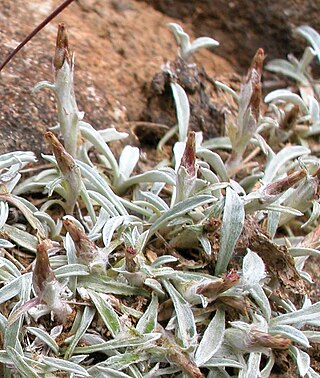
Euchiton traversii, commonly known as mat cudweed, is a small, woolly, alpine rosette herb. It forms a mat-like habit, hence the common name, in alpine wet heath and grasslands. The species is found in Australia—in Tasmania, Victoria, New South Wales, Australian Capital Territory—and the North and South Islands of New Zealand.
















